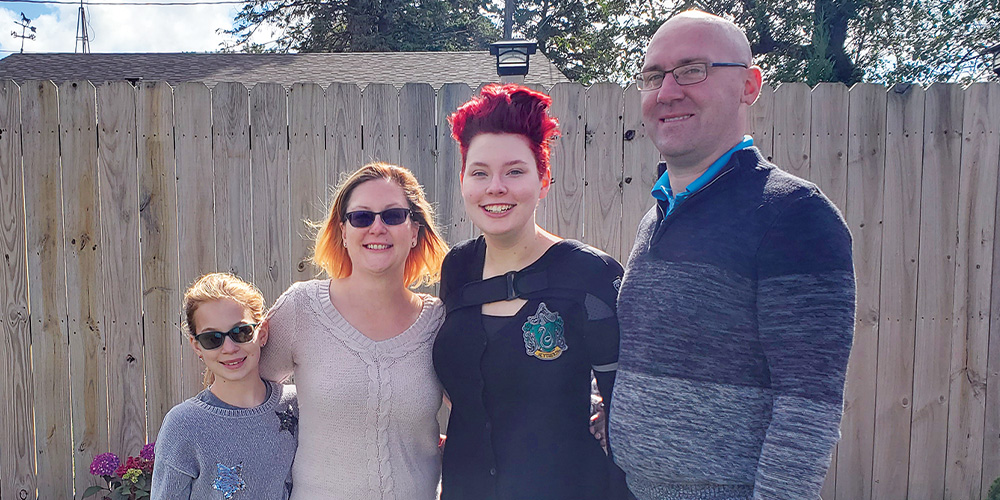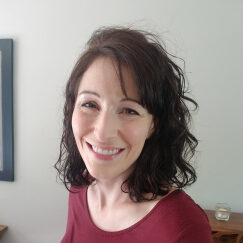 |
A startling medical diagnosis brings a family closer to God.
Chronic pain. Constant exhaustion. Medications. Physical therapy. Surgery after surgery. This is the reality for 16-year-old Bailey Seal, member at Immanuel, Manitowoc, Wis. Bailey was diagnosed four years ago with Ehlers-Danlos Syndrome (EDS), a genetic condition with no cure. Although each day is difficult, Bailey keeps a positive attitude. “When people ask me how I deal with this, I say that I go to God for help,” she says.
Getting a diagnosis
Ehlers-Danlos Syndrome affects the connective tissues in the body, which can result in overly flexible joints and fragile skin. The severity of the symptoms can vary from person to person. Bailey, for example, has joints that are extremely flexible and move far beyond the normal range of motion. Each day her body has to work very hard to keep her joints stable, but even with that extra effort, Bailey says that her knees, ankles, shoulders, wrists, or fingers can dislocate more than 20 times per day. For Bailey, each day is filled with pain and exhaustion.
Before she was diagnosed with EDS, however, Bailey was living life like a normal 12-year-old. “I loved playing sports and going out to do stuff with my friends,” she says. But by the time she was 13, things started becoming difficult for her.
Bailey’s mom, Amanda, clearly remembers the day Bailey was diagnosed with EDS. “We went in for just an ordinary doctor visit and right away the doctor said, ‘Hold on, something else is wrong. You need to go see a geneticist because I think you have Ehlers-Danlos Syndrome.’ ”

Because some types of EDS are inherited and passed from parent to child, Amanda was also tested; the results showed that both she and Bailey have EDS. “It was a slap in the face; we weren’t expecting something so drastic,” Amanda says. Amanda had been dealing with health issues since she was a teenager, but her symptoms had always been dismissed or explained away. Now, it all made sense. “It’s like a light bulb turned on,” she says.
After the diagnosis, Amanda began aggressive treatment for her own EDS and carefully watched Bailey’s developing symptoms. “Any time she said that a joint didn’t feel right, we jumped on it right away,” says Amanda. “We never dismiss anything she says.”
Making adjustments
Armed with knowledge about their condition, the Seals modified their lifestyle to make it less stressful on their joints. For example, they identified things in their day-to-day lives that could cause a fall—something that happens easily when their ankles, knees, or hips dislocate. “We’ve designed our house so there are no rugs lying around,” says Amanda. If she does fall, Amanda says her husband helps catch her. “He doesn’t have EDS, but he’s learned the signs and symptoms. He helps us significantly.”
Bailey also has a great support system at school. She attends Manitowoc Lutheran High School with a group of friends whom she’s known since preschool. They help her with day-to-day activities like opening her locker and getting to class. When Bailey was diagnosed, her friends were very nervous and worried about her condition, but Bailey says they are used to it now. Every so often, a new friend gets scared when Bailey’s joints dislocate. “Then we sit down and have a chat and explain to them what’s going on,” says Amanda. “Then they feel more comfortable and at ease.”
Bailey also needed to make modifications to her school schedule. She can no longer participate in gym class, and sitting or standing for long periods can be very painful for her. So her teachers allow Bailey to leave class when she’s not feeling well, and they excuse her from class a little bit early each day so she can avoid getting bumped by other kids in the halls. When Bailey has surgery, they help her find alternatives for completing assignments and exams, if needed. “One of Bailey’s teachers even brought her homework home for her,” says Amanda. “You don’t see teachers do that. They are really caring.”
Amanda says she’s so grateful for how adaptable and helpful the school has been. “When we contact them about the modifications Bailey needs, they say, ‘Okay, all she has to do is this,’ ” says Amanda. “Manitowoc Lutheran has just been so wonderful.”
Ongoing challenges
In addition to navigating the day-to-day challenges, Bailey also has to deal with ongoing surgeries to repair her deteriorating joints. She’s had four surgeries in the past four years, and another one is coming up. “Surgeries help me have a semi-normal life,” says Bailey. Unfortunately, the surgeries only help for so long. In between surgeries, Bailey relies on pain medications and wears braces to support her joints.
Amanda, who has already had nine surgeries in her life, says living with this condition has been challenging, and she realizes it is worse for Bailey, whose symptoms are more severe. Amanda says Bailey’s younger sister is also starting to have some symptoms and will likely be diagnosed with EDS when she is older.
“It’s so hard to watch your children be in pain day after day, to watch them not do the activities they love or miss out on joining their friends because their bodies can’t handle it,” she says.
Since there’s a 50 percent chance that the gene that causes EDS could be passed down, Bailey has already decided not to have her own biological children. Although it’s heartbreaking, Bailey’s family supports her decision. “We understand,” says Amanda. “And since Bailey loves dogs, we’ll have grand-dogs instead of grandkids—and we’re good with that.”
Relying on God
Amanda says this experience has strengthened her relationship with God. “Before my diagnosis I would pray to God, asking him to take away my pain. Now I pray that he allows me to get the tasks done that need to be done for the day. I pray that he keeps our daughters strong and doesn’t let their joints break from having EDS. I pray that they never lose faith in Jesus or be angry that they have EDS. I pray that he will never give them more than what they can handle.”
Bailey says this syndrome has changed her. “At first, I was really angry at God for letting this happen to me. But now I know that he is using all these problems to bring me closer to him,” she says.
This is especially true on her hardest days. “Sometimes my pain gets really bad to the point I want to cry, and I have a really high pain tolerance,” she says. So she tries to focus on the things she loves—like drawing, singing, and playing drums.
But she says that the thing that always helps is when she turns to God. “I trust that God will take care of me and will help me get through this. I know that EDS is a lifelong thing, but I trust that God will never leave me alone. One day he will take me to heaven, and I won’t have to worry about which joint is going to dislocate next.”
Author: Alicia Neumann
Volume 107, Number 12
Issue: December 2020
- My Christian life: A pastor with brain cancer finds true strength
- My Christian life: I have depression, but Jesus has me
- My Christian life: An unexpected call to ministry later in life
- My Christian life: Breaking barriers in Milwaukee and beyond
- My Christian life: Perspectives from a lay missionary
- My Christian life: One serviceman’s faith journey
- My Christian life: Navajo shepherdess finds joy in Jesus
- My Christian life: One woman’s gratitude for being excommunicated
- My Christian life: Making music as a family
- My Christian life: Engaging the church’s youth
- My Christian life: Leading as a Christian in the business world
- My Christian life: Fulfilling physical and spiritual needs
- My Christian life: Raising a child with special needs
- My Christian life: Premature twins defy medical odds
- My Christian life: College student recovers after rare diagnosis
- My Christian life: The reality of being a Vietnam veteran
- My Christian life: When vocation and ministry collide
- My Christian life: From Air Force sergeant to staff minister
- My Christian life: Faith provides firm foundation after cancer diagnosis
- My Christian life: From prospect to pastor
- My Christian life: The unique path of embryo adoption
- My Christian life: Turning tragedy into blessing
- My Christian life: A Malawian Christian committed to serving others
- My Christian life: Pen pal shares faith with prisoners
- My Christian life: Born deaf to a hearing family
- My Christian life: A single mother finds a new beginning
- My Christian life: Finding real Christmas joy while in the hospital
- My Christian life: Holding up the prophets’ hands
- My Christian life: One man’s battle with anxiety
- My Christian life: Heart transplant inspires a life of service
- My Christian life: Finding true peace through Psalm 23
- My Christian life: An incredible harp-playing journey
- My Christian life: Highlighting the Scriptures through art
- My Christian life: Serving in retirement as a vacancy pastor
- My Christian life: A man of truth
- My Christian life: The sign maker
- My Christian life: Once a detective, now a pastor
- My Christian life: A Ukrainian mother chooses life
- My Christian life: Teen faces difficult medical diagnosis
- My Christian life: Music as a companion on life’s journey
- My Christian life: WELS nurse lives out faith through her vocation
- My Christian life: A teacher retires full of memories
- My Christian life: On the front lines of a pandemic
- My Christian life: Dealing with mental illness
- My Christian life: Camp BASIC
- My Christian life: Battling cancer as a teenager
- My Christian life: Spencer Beach
- My Christian life: Mission opportunities in South Asia
- My Christian life: Haiti adoptions







